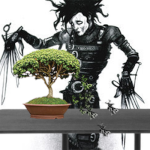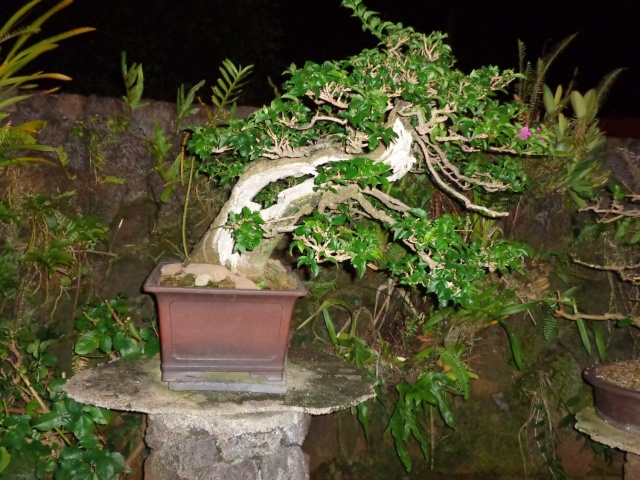project evaluations
5 posters
Page 1 of 1
 project evaluations
project evaluations
a mentor once said, if you want to see what your tree really looks like, take a picture of it. so true. what your eyes see and what pictures show are often quite different. pictures don't lie, a wise person once observed. against a solid backdrop, flaws are easy to see. for instance; the large bougainvillea has good bones. most of the elements for a nice bonsai someday. strong wide base, nice movement/taper in the trunk, old textured bark, good branch location. for the future, branch development/ thickening and movement, secondary and tertiary branch growth and defined pad/ canopy development are the goals. the bunjin needs work. pad development, branch thinning, deadwood elimination, different/smaller pot, new planting angle, etc. btw, the left most piece of deadwood forming the circle is not part of the composition. it's merely a support. the branching /pads for the juniper and rock could be placed more effectively to fill negative spaces. new branch and pad growth at the back of the tree would be helpful. rewire and compact the long straight branch extending beyond the pot to compress the composition, introduce movement/fill negative space.
best wishes, sam
 [/url
[/url [/url
[/url
best wishes, sam
 [/url
[/url [/url
[/url
kauaibonsai- Member
 Re: project evaluations
Re: project evaluations
As an artist I would often tell beginners to look at their paintings in a mirror,seeing the image in a different way may well show up design or composition flaws that one does not see when concentrating on one particular aspect too much, may well work with bonsais

Michael Cooper- Member
 Re: project evaluations
Re: project evaluations
great trees, the first juniper especially caught my eye. The knobby trunk of the elm is great.
Good bones on all these trees.
Good bones on all these trees.

Leo Schordje- Member
 Re: project evaluations
Re: project evaluations
Good thread.
Question. When is the optimal and/or latest time to wire bougainvillea branches (how old)? I know they can get hard and stubborn after a while so I want to know for my newly acquired stumps.
I also notice 2 types of branches...the long, straight, fast growing kind and the twiggy kind. How do you encourage the twiggy growth? The twiggy seem to be more flexible even after a while and also have much compact node spacing. Do you notice this?
Thanks!
Question. When is the optimal and/or latest time to wire bougainvillea branches (how old)? I know they can get hard and stubborn after a while so I want to know for my newly acquired stumps.
I also notice 2 types of branches...the long, straight, fast growing kind and the twiggy kind. How do you encourage the twiggy growth? The twiggy seem to be more flexible even after a while and also have much compact node spacing. Do you notice this?
Thanks!

Poink88- Member
 Re: project evaluations
Re: project evaluations
good observations, dario.
I wire usable shoots as soon as they can withstand light wire. when the growth is young, soft and still green, this is a good time to apply wire (somewhat loosely) not only for up/down bends, but also to introduce movement to the branch. if the shoots are not positioned early, the growth hardens, making a 90 degree bend difficult/impossible . common purple shoots are more forgiving than red which does not like to be bent at the trunk. the red shoot often breaks away as soon as pressure is applied.
as to branch growth, I wish I could figure out and control which new shoot will become the jack in the bean stalk branch; the one that grows thick and straight with large thorns and big leaves. if we could get these to grow only where we want to develop the main branches, life would be so much easier. the smaller slower developing branches, these grow wherever, seemingly without rhyme or reason. this is why one often sees a bonsai developed from raw material with branches of different thicknesses all over the trunk; certainly not following the simple logic of the thickest branches always being at the bottom. the tree has it's own mind and every tree has a different growth plan. if a slow growing branch pops at the bottom of the trunk, many say, allow the branch to grow unrestrained and automatically one will get the thick branch you need. in my own experience, this is not always so. another observation; as easy as bougainvillea grow, they can be finicky grown as bonsai. unexplained branch die off, I'm talking about thick main structural branches, is a major problem. you think you're almost there; suddenly a main branch turns it's toes up and you're looking at starting all over again. all in a days work!
best wishes, sam
I wire usable shoots as soon as they can withstand light wire. when the growth is young, soft and still green, this is a good time to apply wire (somewhat loosely) not only for up/down bends, but also to introduce movement to the branch. if the shoots are not positioned early, the growth hardens, making a 90 degree bend difficult/impossible . common purple shoots are more forgiving than red which does not like to be bent at the trunk. the red shoot often breaks away as soon as pressure is applied.
as to branch growth, I wish I could figure out and control which new shoot will become the jack in the bean stalk branch; the one that grows thick and straight with large thorns and big leaves. if we could get these to grow only where we want to develop the main branches, life would be so much easier. the smaller slower developing branches, these grow wherever, seemingly without rhyme or reason. this is why one often sees a bonsai developed from raw material with branches of different thicknesses all over the trunk; certainly not following the simple logic of the thickest branches always being at the bottom. the tree has it's own mind and every tree has a different growth plan. if a slow growing branch pops at the bottom of the trunk, many say, allow the branch to grow unrestrained and automatically one will get the thick branch you need. in my own experience, this is not always so. another observation; as easy as bougainvillea grow, they can be finicky grown as bonsai. unexplained branch die off, I'm talking about thick main structural branches, is a major problem. you think you're almost there; suddenly a main branch turns it's toes up and you're looking at starting all over again. all in a days work!
best wishes, sam
kauaibonsai- Member
 Re: project evaluations
Re: project evaluations
Thanks a lot Sam! 
This post surely is something all new bougie grower should read.
This post surely is something all new bougie grower should read.

Poink88- Member
 Re: project evaluations
Re: project evaluations
Thanks very much Kauaibonsai for the excellent bougie wiring write up and thanks, as well, to Poink88 for asking the question. I agree that this is great information for anyone starting to work with bougies.
Jane
Jane
Jaybirds- Member
 Re: project evaluations
Re: project evaluations
They are all turning out well Sam.Congratulations! a few more years and they will all be killers.
As for the pictures being helpful in the design process. I couldn't agree more. Some time in my case, I took dozens of pictures in one sessions. I found it to be a very significant tool in the design. You will see a lot that is not visible with your own "3D" eyes, like major branches crossing each other, unbalance outline etc. But May I just suggest if you won't mind?, A plain background (dark or black color) is better than taking pictures at night or with camera flash. It will provide you with more realistic depth of the tree specially the branches. With a camera flash, the tree lost its highlights and the foreground mixes with the rear elements of the tree. With a backround/backdraft provided, even a simple mobile phone camera will result in a stunning details. Almost all of my pictures here were taken using phone Iphone camera.
regards,
jun
As for the pictures being helpful in the design process. I couldn't agree more. Some time in my case, I took dozens of pictures in one sessions. I found it to be a very significant tool in the design. You will see a lot that is not visible with your own "3D" eyes, like major branches crossing each other, unbalance outline etc. But May I just suggest if you won't mind?, A plain background (dark or black color) is better than taking pictures at night or with camera flash. It will provide you with more realistic depth of the tree specially the branches. With a camera flash, the tree lost its highlights and the foreground mixes with the rear elements of the tree. With a backround/backdraft provided, even a simple mobile phone camera will result in a stunning details. Almost all of my pictures here were taken using phone Iphone camera.
regards,
jun
Guest- Guest
 Similar topics
Similar topics» JOB PROJECT
» European hornbeam small seedling yamadori
» Yew project
» Itoigawa--project
» My New Project #3
» European hornbeam small seedling yamadori
» Yew project
» Itoigawa--project
» My New Project #3
Page 1 of 1
Permissions in this forum:
You cannot reply to topics in this forum







 [/url
[/url [/url
[/url [/url
[/url
 [/url
[/url [/url
[/url [/url
[/url [/url
[/url [/url
[/url [/url
[/url